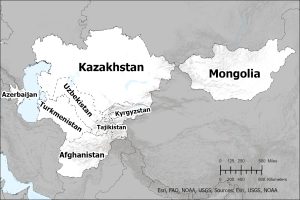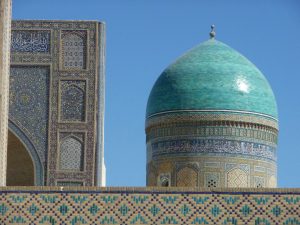79 Central Asia

How do we define this region?
As we have with other regions, as geographers we seek to group similarities together in a region. What do we find that makes a coherent Central Asia?
A key shared characteristic of Central Asia is low population density. Mongolia is the least densely populated country in the world with over 600,000 square miles of area, but only five people per square mile.
| Central Asian Country | Population Density (people per square mile) |
American state | Population Density |
|---|---|---|---|
| Mongolia | 5 | South Dakota | 4 |
| Kazakhstan | 17 | Maine | 17 |
| Turkmenistan | 31 | West Virginia | 30 |
| Tajikistan | 64 | South Carolina | 62 |
| Uzbekistan | 73 | Indiana | 71 |
| Kyrgyzstan | 82 | Virginia | 81 |
| Afghanistan | 137 | Florida | 141 |
| Azerbaijan | 298 | Connecticut | 287 |

These low numbers of people even in large areas such as Mongolia and Kazakhstan are directly correlated with the key physical landscape characteristics of the region. The dominant landscapes are mountains and deserts, both of which cannot sustain large populations. Additionally, all these countries are landlocked, a major hindrance to international trade and economic development. Mongolia features high elevations including the Gobi Desert, the world’s highest elevation desert. Turkmenistan is entirely desert. Kazakhstan has desert areas, but is mainly a vast steppe, similar to America’s Great Plains. Kyrgyzstan and Tajikistan are entirely mountainous. Mostly, Afghanistan is either mountain or desert. Azerbaijan mixes lowlands with segments of the Caucasus Mountains. These features naturally limit population size throughout the region.
Furthermore, Central Asia is landlocked. Without any ocean coastline (or even coastline on a sea that connects to the ocean), Central Asia cannot participate in ocean-going international trade. This is a tremendous disadvantage and precludes the idea of large seaports. Participation in international fisheries obviously is excluded as well. While the Caspian Sea provides some fisheries in the region, it does not connect to the world’s oceans.

By religion, the region is uniformly Islamic with the exception of Mongolia (Buddhism about 50%). During their time in the Soviet Union, these contemporary countries (Mongolia influenced by the USSR) were republic of that communist country where religious faith was discouraged. Islam suffered but persevered and renewed itself after the Soviet Union’s breakup.
During the 13th and 14th centuries, most of Central Asia had been conquered by the Mongols. Much later, Central Asia fell under the rule the Russian Empire, quite fully by the end of the 19th century. With the fall of the Russian Empire to revolution in 1917, the empire’s communist heirs gained control of the region. The principal relic of these communist years is the rule of government in Central Asia, where strong dictators have limited democracy, in some cases very much imitating Stalinist rule of the Soviet Union. This has been most evident in Turkmenistan, where two rulers have successively ruled in a ruthless and somewhat comical, certainly bizarre, manner.
Afghanistan’s experience with Russia/USSR was somewhat different. While the Russian Empire controlled Central Asia, it was the British Empire pushing northward seeking gains in Afghanistan. The British failure to conquer Afghanistan apparently did not deter the Soviet Union from trying to do the same with an invasion in late 1979 and war in the 1980s. The Soviet failure to conquer Afghanistan apparently did not deter the United States from trying to oust the Taliban and transform the country into a democratic state. As we know in 2021, this failed as well.
Azerbaijan also has slightly different circumstances. This state is situated on the west side of the Caspian Sea, in contrast to the rest of Central Asia. It too fell to Russia and the Soviet Union, but with its neighboring Christian countries Armenia and Georgia. However, it fits Central Asia well enough, while its alternatives of Europe or NAME are awkward regional fits.
Major native languages of Central Asia are Turkic. Turkic languages include Turkish, so be carefully of the terminology. All of the national languages of Central Asia are in the Turkic family, except for Afghanistan and Tajikistan. In Afghanistan there is no such thing as the “Afghan” language. Instead, small minorities do speak the Turkic languages of Kyrgyz, Turkemen, and Uzbek respectively. Tajik is in the Iranian language family, being similar to Persian.
The “-stans.”
This is a less scholarly inclusion. Which countries of the world end in -stan? Six of the countries of Central Asia do.
- Afghanistan
- Kazakhstan
- Kyrgyzstan
- Tajikistan
- Turkmenistan
- Uzbekistan
Not in the region, but some would argue for its inclusion.
- Pakistan
In the region, but not ending in -stan.
- Azerbaijan
The suffix -stan in Turkic languages means “the land of.” Thus, Kazakhstan is the land of the Kazakhs, and so on. The country name Azerbaijan has two primarily proposed derivations that both refer to “a land of fire” that may be appropriate given the country’s oil reserves.

As with many regional or country names, the suffix -ia also means “the land of.” Thus, Russia is land of the Russians, Czechia is the land of the Czechs, while Australia is the southern land (as “austral” means southern in Latin based languages). So, the remaining country in Central Asia – Mongolia – is the land of the Mongols.
Overall then, we have landlocked -stan countries featuring desert and/or mountains geographies, where uncrowded Turkic speaking populations practice the Islamic faith. These now independent countries were in or greatly affected by the Russian Empire and then the Soviet Union.
ACRONYM
TRAIL USE
T – Turkic
R – Russian Empire, then Soviet Union
A – Arid (desert)
I – Islam
L – Landlocked
U – Uncrowded (low population density)
S – -stan
E – Elevated (mountain)
Did you know?
The online quiz website Sporcle offers a quiz, directing you to identify the seven -stan countries by their shapes. Try it at: https://www.sporcle.com/games/mszzz/stancountriesbyoutlines
Also on Sporcle, there is a quiz for countries ending in -ia, providing a six minute clock to name 39 countries. A challenge at: https://www.sporcle.com/games/g/iacountries
Among the republics of the new Russia, there are three -stans – Bashkortostan, Dagestan, and Tatarstan. Like in Central Asia, these too are majority Islamic regions.
Hot off the Press!
In the Freakonomics suite of podcasts, a relative new addition is The Economics of Everyday Things podcast that offers analysis of interesting but perhaps mundane topics. To learn about goats in Mongolia, listen to this episode https://freakonomics.com/podcast/cashmere/ .
Cited and additional bibliography:
Luciano. Bukhara. October 7, 2012. Photo. https://www.flickr.com/photos/30208099@N00/8445725606/. Attribution 2.0 Generic (CC BY 2.0).
Philippian, Samuel. Central Asia. College of DuPage GIS class. July 2022.
Soukup, Honza. Gobi X. April 9, 2008. Photo. https://www.flickr.com/photos/honzasoukup/2398223063/. Attribution 2.0 Generic (CC BY 2.0).
Wiertz, Steven. Central Asia. College of DuPage GIS class. July 2022.

